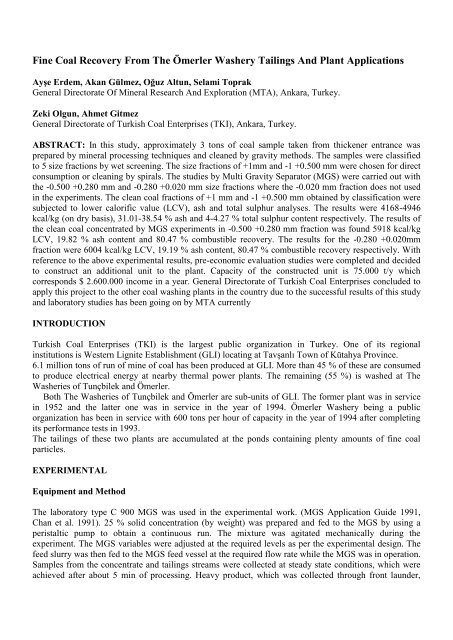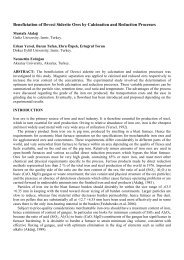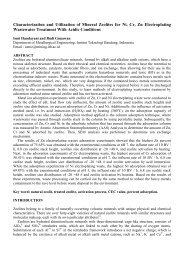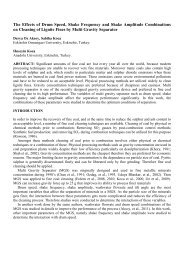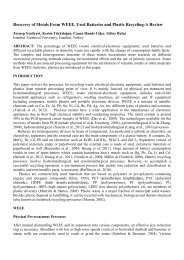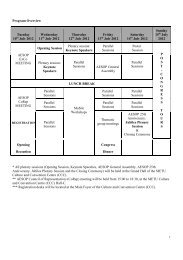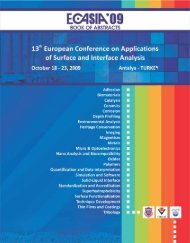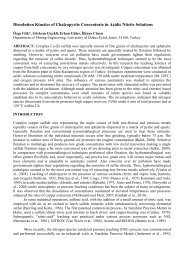Fine Coal Recovery From The Ömerler Washery Tailings And Plant ...
Fine Coal Recovery From The Ömerler Washery Tailings And Plant ...
Fine Coal Recovery From The Ömerler Washery Tailings And Plant ...
You also want an ePaper? Increase the reach of your titles
YUMPU automatically turns print PDFs into web optimized ePapers that Google loves.
<strong>Fine</strong> <strong>Coal</strong> <strong>Recovery</strong> <strong>From</strong> <strong>The</strong> <strong>Ömerler</strong> <strong>Washery</strong> <strong>Tailings</strong> <strong>And</strong> <strong>Plant</strong> Applications<br />
Ayşe Erdem, Akan Gülmez, Oğuz Altun, Selami Toprak<br />
General Directorate Of Mineral Research <strong>And</strong> Exploration (MTA), Ankara, Turkey.<br />
Zeki Olgun, Ahmet Gitmez<br />
General Directorate of Turkish <strong>Coal</strong> Enterprises (TKI), Ankara, Turkey.<br />
ABSTRACT: In this study, approximately 3 tons of coal sample taken from thickener entrance was<br />
prepared by mineral processing techniques and cleaned by gravity methods. <strong>The</strong> samples were classified<br />
to 5 size fractions by wet screening. <strong>The</strong> size fractions of +1mm and -1 +0.500 mm were chosen for direct<br />
consumption or cleaning by spirals. <strong>The</strong> studies by Multi Gravity Separator (MGS) were carried out with<br />
the -0.500 +0.280 mm and -0.280 +0.020 mm size fractions where the -0.020 mm fraction does not used<br />
in the experiments. <strong>The</strong> clean coal fractions of +1 mm and -1 +0.500 mm obtained by classification were<br />
subjected to lower calorific value (LCV), ash and total sulphur analyses. <strong>The</strong> results were 4168-4946<br />
kcal/kg (on dry basis), 31.01-38.54 % ash and 4-4.27 % total sulphur content respectively. <strong>The</strong> results of<br />
the clean coal concentrated by MGS experiments in -0.500 +0.280 mm fraction was found 5918 kcal/kg<br />
LCV, 19.82 % ash content and 80.47 % combustible recovery. <strong>The</strong> results for the -0.280 +0.020mm<br />
fraction were 6004 kcal/kg LCV, 19.19 % ash content, 80.47 % combustible recovery respectively. With<br />
reference to the above experimental results, pre-economic evaluation studies were completed and decided<br />
to construct an additional unit to the plant. Capacity of the constructed unit is 75.000 t/y which<br />
corresponds $ 2.600.000 income in a year. General Directorate of Turkish <strong>Coal</strong> Enterprises concluded to<br />
apply this project to the other coal washing plants in the country due to the successful results of this study<br />
and laboratory studies has been going on by MTA currently<br />
INTRODUCTION<br />
Turkish <strong>Coal</strong> Enterprises (TKI) is the largest public organization in Turkey. One of its regional<br />
institutions is Western Lignite Establishment (GLI) locating at Tavşanlı Town of Kütahya Province.<br />
6.1 million tons of run of mine of coal has been produced at GLI. More than 45 % of these are consumed<br />
to produce electrical energy at nearby thermal power plants. <strong>The</strong> remaining (55 %) is washed at <strong>The</strong><br />
Washeries of Tunçbilek and <strong>Ömerler</strong>.<br />
Both <strong>The</strong> Washeries of Tunçbilek and <strong>Ömerler</strong> are sub-units of GLI. <strong>The</strong> former plant was in service<br />
in 1952 and the latter one was in service in the year of 1994. <strong>Ömerler</strong> <strong>Washery</strong> being a public<br />
organization has been in service with 600 tons per hour of capacity in the year of 1994 after completing<br />
its performance tests in 1993.<br />
<strong>The</strong> tailings of these two plants are accumulated at the ponds containing plenty amounts of fine coal<br />
particles.<br />
EXPERIMENTAL<br />
Equipment and Method<br />
<strong>The</strong> laboratory type C 900 MGS was used in the experimental work. (MGS Application Guide 1991,<br />
Chan et al. 1991). 25 % solid concentration (by weight) was prepared and fed to the MGS by using a<br />
peristaltic pump to obtain a continuous run. <strong>The</strong> mixture was agitated mechanically during the<br />
experiment. <strong>The</strong> MGS variables were adjusted at the required levels as per the experimental design. <strong>The</strong><br />
feed slurry was then fed to the MGS feed vessel at the required flow rate while the MGS was in operation.<br />
Samples from the concentrate and tailings streams were collected at steady state conditions, which were<br />
achieved after about 5 min of processing. Heavy product, which was collected through front launder,
eferred to as tailings, and light product, which was collected through back launder, referred to as<br />
concentrate. <strong>The</strong> samples were filtered, dried, and analysed for ash, sulphur and LCV.<br />
Sample<br />
Approximately 3 tons of samples were taken from entrance of TKI-GLI-<strong>Ömerler</strong> <strong>Washery</strong> tailing<br />
thickener. <strong>The</strong> samples were mixed and obtained a homogenously composite sample.<br />
<strong>The</strong> slurry sample was then wet sieved into four size fractions; +0.500; -0.500 +0.280; -0.280 +0.020<br />
and -0.020 mm. <strong>The</strong> sieve analysis, ash, total sulphur, LCV and combustible recovery of fractions are<br />
given in Table 1. <strong>The</strong> +0,500 mm fraction was not used in experimental studies because of that fraction<br />
be able to directly selling or available (cleanable) at spirals; –0.500 +0.280 and –0.280 +0.020 mm<br />
fractions were cleaned by MGS. Preliminary experiments revealed that –0.020 mm fraction was not<br />
effectively cleaned by physical methods and therefore was not used in the experimental work.<br />
Table 1. <strong>The</strong> sieve analysis of the composite sample on dry basis<br />
Particle Size, Weight Grade (%)<br />
mm<br />
(%)<br />
Ash S LCV, kcal/kg<br />
+1 1.56 31.01 4.00 4946<br />
-1 +0.500 5.11 38.54 4.27 4168<br />
-0.500 +0.280 7.90 34.69 3.60 4435<br />
-0.280 +0.150 4.76 34.45 3.11 4544<br />
-0.150 +0.100 3.49 35.82 3.03 4402<br />
-0.100 +0.055 5.24 42.10 2.69 3878<br />
-0.055 +0.038 2.33 47.70 2.28 3279<br />
-0.038 +0.020 2.69 54.44 1.99 2868<br />
-0.020 66.94 77.92 0.76 707<br />
Feed 100.00 65.02 1.57 1840<br />
<strong>The</strong> general studies of abovementioned work to determine both physical and chemical properties of<br />
output of coal washing plant, one can summarize;<br />
<strong>The</strong>re is a significant density difference between coal and gangue,<br />
About 6.67 % of sample has an over 0.500 mm. particle size,<br />
<strong>The</strong> coal particle size is average 10 microns in the -20 microns sized slurry fraction having 66.94 %<br />
weight of the sample and 707 kcal /kg. of LCV,<br />
<strong>The</strong> LCV of sample vary from 3868 to 4946 kcal /kg. at over 20 microns particle sized sieve fractions,<br />
<strong>The</strong> MGS experiments reveal that the prepared sample has 7.90 % by weight at -0.500 +0.280 mm.<br />
and 18.51 % by weight at -0.280 +0.020 mm. sieve fractions<br />
<strong>The</strong> Russell branded wet -sieve system is employed for preparation of different sized fractions of<br />
sample.<br />
<strong>The</strong> fractions of samples used in the experiments of MGS are both the fractions of -0.500 +0.280 mm.<br />
and -0.280 +0.020 mm. But, the fraction of -0.020 mm. is removed as slurry without any treatment.<br />
Experiments<br />
MGS Experiments at -0.500 +0.280 Fraction<br />
Wash water flow rate, drum speed and tilt of the drum were tested to determine optimum conditions of<br />
separation. Shake frequency and shake amplitude of the MGS were predetermined and set as 4 cps and 10<br />
mm, respectively. Results are illustrated in graphs in terms of ash content and combustible recovery in the
concentrate fraction. <strong>The</strong> results for coarse (-0.500 +0.280 mm) fraction are given in Table 2 and Figure<br />
1.<br />
Table 2. Optimum values for -0.500 +0.280 particle size<br />
TILT<br />
DEGREES º<br />
CONCENTRATE (%)<br />
Weight Dry Ash Sulphur Combustible <strong>Recovery</strong> LCV<br />
kcal/kg<br />
0 67.37 21.28 1.82 84.11 5892<br />
1 69.51 19.82 1.19 85.24 5918<br />
2 78.13 25.63 1.19 90.64 5450<br />
Concentrate,%<br />
100<br />
80<br />
60<br />
40<br />
20<br />
0<br />
0 1 2 3 4<br />
Tilt of Drum, º<br />
Figure 1. Optimum values graph of tilt degrees for -0.500 +0.280 mm particle size<br />
<strong>The</strong> effect of wash water was studied at three different flow rates, i.e. 1, 2 and 3 l/min and drum speed<br />
and tilt of drum were adjusted as 240, 260 and 280 rpm and 0, 1 and 2�, respectively.<br />
When Washing water and speed of drum are examined, one can say that the increasing of washing<br />
water causes the picking up of ash content and decreasing of LCV.<br />
<strong>The</strong> stratification of sample in the MGS takes place from surface to inward that decreasing of the<br />
density. <strong>The</strong> particles having less density on upper part of the strata are transported to the back exit of the<br />
device due to the effects of washing water. But, the denser particles sitting inside of drum are drifted to<br />
the front exit by scrapers. Here, the denser particles have the same revolution direction with the drum.<br />
<strong>The</strong> scraper’s revolution speed is more than the particle’s speed, however. <strong>The</strong> more the washing water<br />
means the more the drifted light material toward the back exit. Relatively, that makes an increase of ash,<br />
too.<br />
<strong>The</strong> increasing of the tilt of the drum causes the increase of amount of concentrate. But, the<br />
transportation by scrapers becomes difficult.<br />
By the operation principle of the MGS, the dense material is taken from the front exit. <strong>The</strong> light<br />
material is taken back front, however.<br />
Weight<br />
Dry Ash<br />
Total Sulphur<br />
Combustible<br />
<strong>Recovery</strong>
MGS Experiments at -0.280 +0.020 Fraction<br />
<strong>The</strong> effect of drum speed, wash water amount, tilt of drum, shake amplitude and shake frequency<br />
parameters studied on this size fraction, respectively. Operation conditions are also specified at<br />
experiments. <strong>The</strong> results are given in Table 3 and Figure 2, respectively.<br />
<strong>The</strong> -0.280 +0.020 mm size fraction which is used in experiments, 18.51 % of the material constitute.<br />
Table 3. Optimum values for -0,280 +0,020 particle size<br />
TILT<br />
DEGREES º<br />
CONCENTRATE (%)<br />
Weight Dry Ash Sulphur Combustible <strong>Recovery</strong> LCV<br />
kcal/kg<br />
0 59.17 19.19 1.63 80.47 6004<br />
1 64.12 21.37 1.19 84.67 5877<br />
2 66.10 22.89 1.19 87.22 5696<br />
Figure 2. Optimum values graph of tilt degrees for -0.280 +0.020 mm particle size<br />
Installation of Industrial <strong>Plant</strong><br />
Concentrate,%<br />
100<br />
80<br />
60<br />
40<br />
20<br />
0<br />
0 1 2 3 4<br />
Tilt of Drum, º<br />
A protocol was signed within the scope of projects carried out jointly between TKI and MTA. By this<br />
protocol, a pilot plant will be established in Tunçbilek <strong>Ömerler</strong> <strong>Washery</strong> whose condition for this purpose<br />
considering appropriate by TKI<br />
<strong>The</strong> plant was supposed to be found nearby outside the washing plant. <strong>The</strong> samples were taken to<br />
conduct mineral processing studies at MTA. <strong>The</strong> technological studies on these samples reveal that fine<br />
coal can be recovered economically and technically.<br />
<strong>The</strong> four alternative methods were presented to the General Directorate of TKI after the result of prefeasibility<br />
studies. By the lights of these technical data, a pilot plant was established at a chosen place at<br />
Tunçbilek <strong>Ömerler</strong> <strong>Washery</strong>. (Table 4)<br />
Weight<br />
Dry Ash<br />
Total Sulphur<br />
Combustible<br />
<strong>Recovery</strong>
Table 4. <strong>The</strong> Alternative Economical Assessment of the <strong>Tailings</strong> of <strong>Ömerler</strong> <strong>Washery</strong><br />
ALTERNATIVES CLASSIFICATION ALTERNATIVE MGS ALTERNATIVE<br />
1-Selling to Power <strong>Plant</strong><br />
Investment ($) 444.583 1.192.811<br />
Running Costs ($/y) 243.731 282.985<br />
Running Incomes ($/y) 4.039.845 3.476.411<br />
Net Present Value ($) 22.230.026 17.996.548<br />
Rate of Return (%) 672 213<br />
2-Selling to Cement Factory<br />
Investment ($) 444.583 1.587.356<br />
Running Costs ($/y) 243.731 282.985<br />
Running Incomes ($/y) 6.633.572 5.708.393<br />
Net Present Value ($) 37.696.849 31.306.225<br />
Rate of Return (%) 1127 360<br />
As a result of evaluations of alternative methods, TKI decided to invest in additional units. To observe<br />
the applicability of this work, the first alternative was accepted. By this first alternative, the additional<br />
unit could provide only classification of fine coal that is saleable to power plants.<br />
RESULTS AND DISCUSSIONS<br />
a. <strong>The</strong> experiments were executed by a C 902 type semi-pilot MGS. <strong>The</strong> optimum laboratory<br />
conditions were determined using drum speed, washing water flow rate, slope of drum as parameters. <strong>The</strong><br />
studies show that purposed plant can produce TKI demanded market products of coal having the various<br />
LCV.<br />
b. When it was evaluated, the lowest value of result is obtained at the -0.500 +0.280 mm. particle<br />
sized product recovered by 98.56 % combustible recovery with 4750 kcal /kg. LCV and having 33.09 %<br />
dry- ash content.<br />
<strong>The</strong> upper value of the result was obtained at 85.24 % of combustible recovery at the same particle<br />
size having 5918 kcal /kg. of LCV and 19.82 % dry –ash content.<br />
c. As for the -0.280 +0.020 mm. sieve fraction, the minimum value of result was obtained at the<br />
product recovered by 91.68 % combustible recovery with 5380 kcal /kg. LCV and having 26.68 % dry-<br />
ash content.<br />
<strong>The</strong> maximum value of the result was reached at 80.47 % of combustible recovery at the same particle<br />
size having 6004 kcal /kg. of LCV and 19.19 % dry –ash content.<br />
d. <strong>The</strong> obtained this quality fine coal can be present to either blending it with the coal having a low<br />
specific calorie to feed the power plants or marketing it to the industrial plants who use fine coal.<br />
e. By the light of studies conducted by Mineral Processing Division of MTA, TKI invested in the<br />
Directorate of GLI of <strong>The</strong> <strong>Washery</strong> of Tunçbilek-<strong>Ömerler</strong> to evaluate of this work economically. As<br />
mentioned above, the first alternative was realized and the plant has been established.<br />
f. As soon as possible the pilot plant had been setup, the industrial scale plant was built and installed<br />
by the date of November, 2009. Since then, the saleable fine coal has been produced at the plant.<br />
g. <strong>The</strong> cost of the investment was regained in two weeks of operations of the plant. It was<br />
determined that the <strong>Washery</strong> of Tunçbilek-<strong>Ömerler</strong> can recover 75.000 tons of fine coal valuing $<br />
2.600.000. This fine coal can market to EÜAŞ (<strong>The</strong> Electrical Production Cooperation).<br />
h. In the year 2011, a new project is initiated to execute same studies on the other washing plants by<br />
jointly TKI and MTA. By the scope of this project, the team of experts have already examined concerning<br />
coal washing plants and decided to be taken enough amount of samples;<br />
� <strong>From</strong> the thickener entrance of Dereköy of Ege Lignite Establishment,<br />
� <strong>From</strong> the thickener output of the <strong>Washery</strong> of Directorate of Seyitömer Lignite Establishment.
REFERENCES<br />
Burt, O.R. 1984. Gravity concentration technology, Elsevier science publishers B.V, Amsterdam. <strong>The</strong><br />
Netherlands, 603 p.<br />
Chan, B.S.K., Mozley, R.H. & Childs, G.J.C. 1991. <strong>The</strong> MGS-A mine scale machine UK, Richard<br />
Mozley ltd.<br />
Erdem, A., Olgun, Z., Gülmez, A., Koca, S. & Öteyaka, B. 2008. Beneficiation of lignites by means of<br />
shaking table, MGS and flotation, Project report 4, Project No. 106G056 (Turkish), MTA, Ankara.<br />
MGS Application Guide. 1991. How to get the best from your C 900 MGS. UK, Richard Mozley ltd.<br />
Kirnarsky, A. & Sbitnev, M. 1998. Development of spiral separation technology for coal slimes<br />
treatment. Proceedings of the fifth international symposium on environmental issues and waste<br />
management in energy and mineral production, Ankara. Turkey, pp.659-662.<br />
Erdem A, Gülmez A ve Altun O. 2010. Beneficiation of lignites by means of shaking table, MGS and<br />
flotation, Project report, Proje No, 106G056 (Turkish), TÜBİTAK, Ankara<br />
www.tki.gov.tr/ activity report (Turkish), 2010.<br />
*This Project supported by TÜBİTAK.


